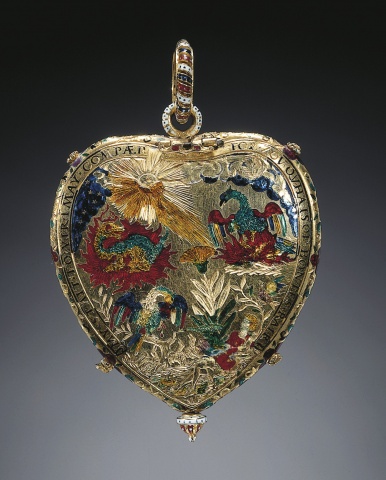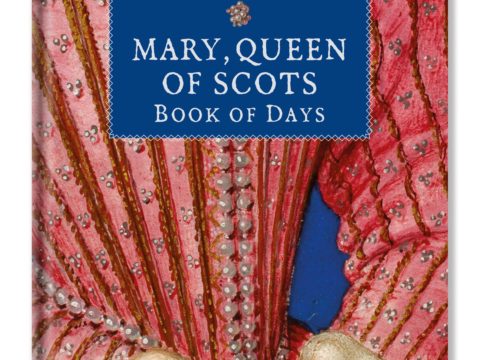'You Seem All My Pleasure': The Lennox Jewel
A Symbol of Love and Political Ambition
Chapter 3 : Reverse
Partially encircling the reverse of the Jewel is the inscription: ‘My state to these I may compare for you, who are of rare goodness.’ Again, it is probably a tribute from Lennox to Margaret. The words surround the sun in splendour – a symbol of royalty and glory, once a badge of the royal House of York - amidst azure clouds symbolising the unseen Divine Presence, which are studded with stars (spiritual light piercing the darkness), with a crescent moon to one corner, having a man’s face in profile: the moon symbolises humanity, the Catholic Church, and, in its monthly rebirth, the Resurrection.

Beneath the sun is a ‘pelican in its piety’, a crowned bird feeding its young with blood from its own breast until it dies, a symbol of the sacrificial maternal love felt by Margaret for her children. She had borne eight, but only two sons, Darnley and Charles, now survived, and her focus now was not on her own claim to the throne – she had been next in line to it twice in the past - but Darnley’s.
Beneath the moon is a salamander, Margaret’s emblem, rising unburned from the fire, reflecting her determination to rise above the difficulties that had befallen her and triumph in the end. She had been intriguing for her son’s marriage since 1560, and had spent over a year under house arrest at Sheen as a result. She was no stranger to prisons, for in 1536 she had been sent to the Tower of London under sentence of death for precontracting herself without Henry VIII’s knowledge or consent, and remained there for sixteen months. And yet, undaunted by her experiences, she was still covertly manoeuvring to bring about the marriage of Darnley to the Queen of Scots.
Generally a salamander represents a righteous soul who remains calm when beset by enemies. But Margaret had been anything but calm during her spells of imprisonment. Her poems relating to her sojourn in the Tower betray her anguish over her lost lover, and from Sheen she continually bombarded William Cecil, Elizabeth I’s chief minister, with outraged letters protesting her innocence. In the future, she was to be imprisoned twice more in the Tower, and face the worst news any mother can receive about her son, which was nearly to break even her strong character.
Some accounts of the Jewel describe the salamander as a phoenix, in which case it may allude to Margaret’s protectiveness of her son. Her ambition for Darnley was the driving force in her life, but she was deluded about him, for he had grown up to be weak, shallow, arrogant, spoilt and vicious, and it would prove his downfall.
In the lower corner of the heart is the figure of a man lying on the grass, who has been identified as Darnley, but is more likely to have symbolised Lennox. The image probably refers to a line in Psalm 23: ‘He maketh me to lie down in green pastures.’ Beside him lies a crown, a symbol both of royal authority and of Christ, and from it sprouts a sunflower, which stands for God’s love and for a soul directing its thoughts and feelings to Heaven; the sunflower opens up its radial petals to the sun, which also symbolises divine love. On the flower rests a lizard, a symbol closely associated with light and sun, and often representing a soul longing for Christ. Behind the recumbent man stands a laurel tree, a symbol of victory and immortality, in which a gaudy little bird is perched; he stands for a saved soul.






